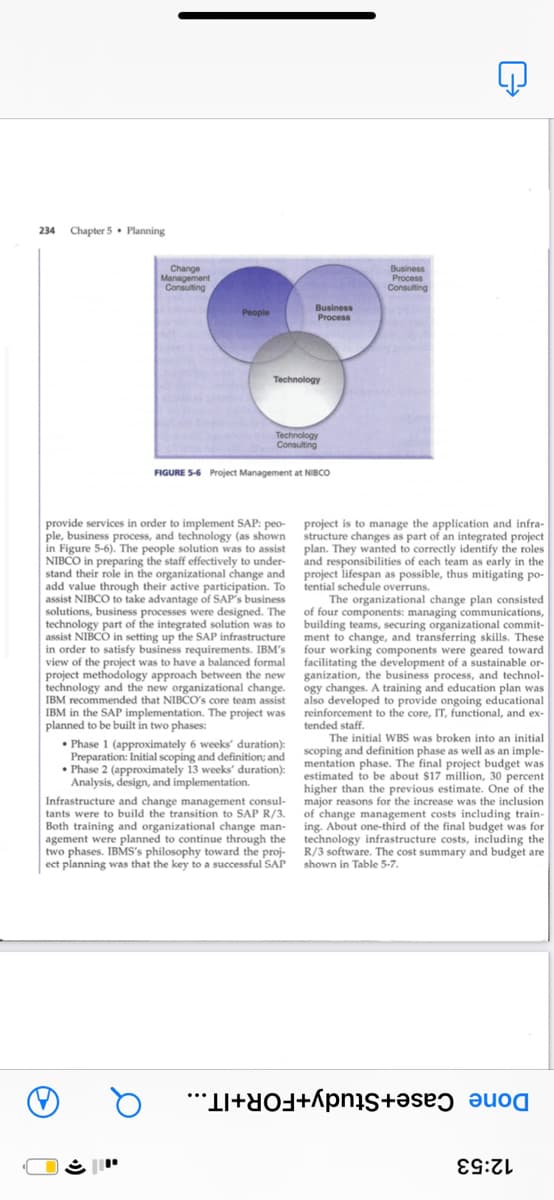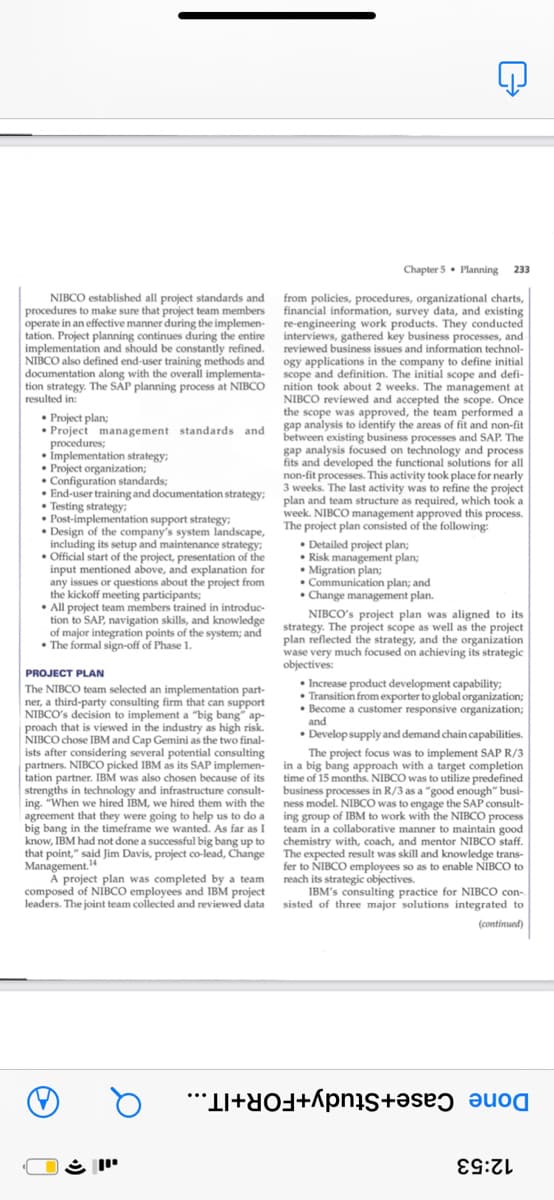1. Using the information in this section, write a project plan for NIBCO. 2. Why is change management so important for NIBCO? 3. Use the WBS and start a project plan using Microsoft Project. Write a rationale for each of the cost summary
1. Using the information in this section, write a project plan for NIBCO. 2. Why is change management so important for NIBCO? 3. Use the WBS and start a project plan using Microsoft Project. Write a rationale for each of the cost summary
Chapter1: Taking Risks And Making Profits Within The Dynamic Business Environment
Section: Chapter Questions
Problem 1CE
Related questions
Question
100%
1. Using the information in this section, write a project
plan for NIBCO.
2. Why is change management so important for
NIBCO?
3. Use the WBS and start a project plan using Microsoft
Project.
Write a rationale for each of the cost summary

Transcribed Image Text:234 Chapter 5• Planning
Change
Management
Consulting
Business
Process
Consulting
Business
Process
People
Technology
Technology
Consulting
FIGURE S-6 Project Management at NIBCO
provide services in order to implement SAP: peo- project is to manage the application and infra-
ple, business process, and technology (as shown structure changes as part of an integrated project
in Figure 5-6). The people solution was to assist
NIBCO in preparing the staff effectively to under- and responsibilities of each team as early in the
stand their role in the organizational change and project lifespan as possible, thus mitigating po-
add value through their active participation. To tential schedule overruns.
assist NIBCO to take advantage of SAP's business
solutions, business processes were designed. The of four components: managing communications,
technology part of the integrated solution was to
assist NIBCO in setting up the SAP infrastructure
in order to satisfy business requirements. IBM's
view of the project was to have a balanced formal
project methodology approach between the new
technology and the new organizational change. ogy changes. A training and education plan was
IBM recommended that NIBCO's core team assist also developed to provide ongoing educational
IBM in the SAP implementation. The project was
planned to be built in two phases:
plan. They wanted to correctly identify the roles
The organizational change plan consisted
building teams, securing organizational commit-
ment to change, and transferring skills. These
four working components were geared toward
facilitating the development of a sustainable or-
ganization, the business process, and technol-
reinforcement to the core, IT, functional, and ex-
tended staff.
The initial WBS was broken into an initial
scoping and definition phase as well as an imple-
mentation phase. The final project budget was
estimated to be about $17 million, 30 percent
higher than the previous estimate. One of the
major reasons for the increase was the inclusion
of change management costs including train-
• Phase 1 (approximately 6 weeks' duration):
Preparation: Initial scoping and definition; and
• Phase 2 (approximately 13 weeks' duration):
Analysis, design, and implementation.
Infrastructure and change management consul-
tants were to build the transition to SAP R/3.
Both training and organizational change man- ing. About one-third of the final budget was for
agement were planned to continue through the technology infrastructure costs, including the
two phases. IBMS's philosophy toward the proj- R/3 software. The cost summary and budget are
ect planning was that the key to a successful SAP shown in Table 5-7.
Done Case+Study+FOR+IT...
12:53

Transcribed Image Text:Chapter 5. Planning
233
NIBCO established all project standards and
procedures to make sure that project team members
operate in an effective manner during the implemen- re-engineering work products. They conducted
tation. Project planning continues during the entire
implementation and should be constantly refined.
NIBCO also defined end-user training methods and ogy applications in the company to define initial
documentation along with the overall implementa- scope and definition. The initial scope and defi-
tion strategy. The SĂP planning process at NIBCO nition took about 2 weeks. The management at
resulted in:
from policies, procedures, organizational charts,
financial information, survey data, and existing
interviews, gathered key business processes, and
reviewed business issues and information technol-
NIBCO reviewed and accepted the scope. Once
the scope was approved, the team performed a
• Project plan;
• Project management standards and gap analysis to identify the areas of fit and non-fit
procedures;
• Implementation strategy;
• Project organization;
• Configuration standards;
• End-user training and documentation strategy; plan and team structure as required, which took a
• Testing strategy;
• Post-implementation support strategy;
between existing business processes and SAP. The
gap analysis focused on technology and process
fits and developed the functional solutions for all
non-fit processes. This activity took place for nearly
3 weeks. The last activity was to refine the project
week. NIBCO management approved this process.
• Design of the company's system landscape, The project plan consisted of the following:
including its setup and maintenance strategy;
• Official start of the project, presentation of the
input mentioned above, and explanation for
any issues or questions about the project from
the kickoff meeting participants;
• All project team members trained in introduc-
tion to SAP, navigation skills, and knowledge strategy. The project scope as well as the project
of major integration points of the system; and
• The formal sign-off of Phase 1.
• Detailed project plan;
• Risk management plan;
• Migration plan;
• Communication plan; and
• Change management plan.
NIBCO's project plan was aligned to its
plan reflected the strategy, and the organization
wase very much focused on achieving its strategic
objectives:
PROJECT PLAN
• Increase product development capability;
• Transition from exporter to global organization;
• Become a customer responsive organization;
and
• Develop supply and demand chain capabilities.
The NIBCO team selected an implementation part-
ner, a third-party consulting firm that can support
NIBCO's decision to implement a "big bang" ap-
proach that is viewed in the industry as high risk.
NIBCO chose IBM and Cap Gemini as the two final-
ists after considering several potential consulting
partners. NIBCO picked IBM as its SAP implemen- in a big bang approach with a target completion
tation partner. IBM was also chosen because of its
strengths in technology and infrastructure consult-
ing. "When we hired IBM, we hired them with the ness model. NIBCO was to engage the SAP consult-
agreement that they were going to help us to do a ing group of IBM to work with the NIBCO process
big bang in the timeframe we wanted. As far as I team in a collaborative manner to maintain good
know, IBM had not done a successful big bang up to chemistry with, coach, and mentor NIBCO staff.
that point," said Jim Davis, project co-lead, Change The expected result was skill and knowledge trans-
The project focus was to implement SAP R/3
time of 15 months. NIBCO was to utilize predefined
business processes in R/3 as a "good enough" busi-
Management."
A project plan was completed by a team
composed of NIBCO employees and IBM project
leaders. The joint team collected and reviewed data sisted of three major solutions integrated to
fer to NIBCO employees so as to enable NĪBCO to
reach its strategic objectives.
IBM's consulting practice for NIBCO con-
(continued)
Done Case+Study+FOR+IT...
12:53
Expert Solution
This question has been solved!
Explore an expertly crafted, step-by-step solution for a thorough understanding of key concepts.
This is a popular solution!
Trending now
This is a popular solution!
Step by step
Solved in 5 steps

Recommended textbooks for you

Understanding Business
Management
ISBN:
9781259929434
Author:
William Nickels
Publisher:
McGraw-Hill Education

Management (14th Edition)
Management
ISBN:
9780134527604
Author:
Stephen P. Robbins, Mary A. Coulter
Publisher:
PEARSON

Spreadsheet Modeling & Decision Analysis: A Pract…
Management
ISBN:
9781305947412
Author:
Cliff Ragsdale
Publisher:
Cengage Learning

Understanding Business
Management
ISBN:
9781259929434
Author:
William Nickels
Publisher:
McGraw-Hill Education

Management (14th Edition)
Management
ISBN:
9780134527604
Author:
Stephen P. Robbins, Mary A. Coulter
Publisher:
PEARSON

Spreadsheet Modeling & Decision Analysis: A Pract…
Management
ISBN:
9781305947412
Author:
Cliff Ragsdale
Publisher:
Cengage Learning

Management Information Systems: Managing The Digi…
Management
ISBN:
9780135191798
Author:
Kenneth C. Laudon, Jane P. Laudon
Publisher:
PEARSON

Business Essentials (12th Edition) (What's New in…
Management
ISBN:
9780134728391
Author:
Ronald J. Ebert, Ricky W. Griffin
Publisher:
PEARSON

Fundamentals of Management (10th Edition)
Management
ISBN:
9780134237473
Author:
Stephen P. Robbins, Mary A. Coulter, David A. De Cenzo
Publisher:
PEARSON